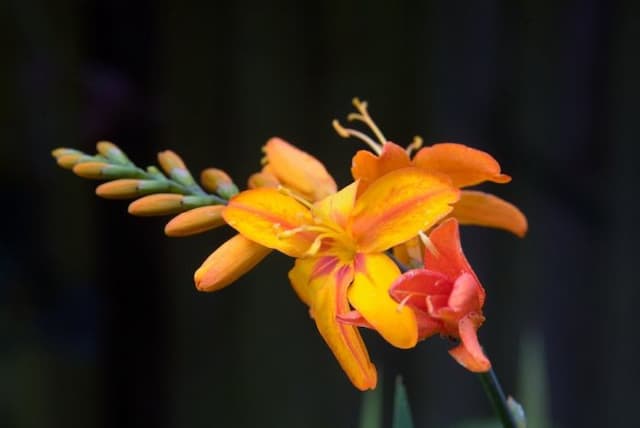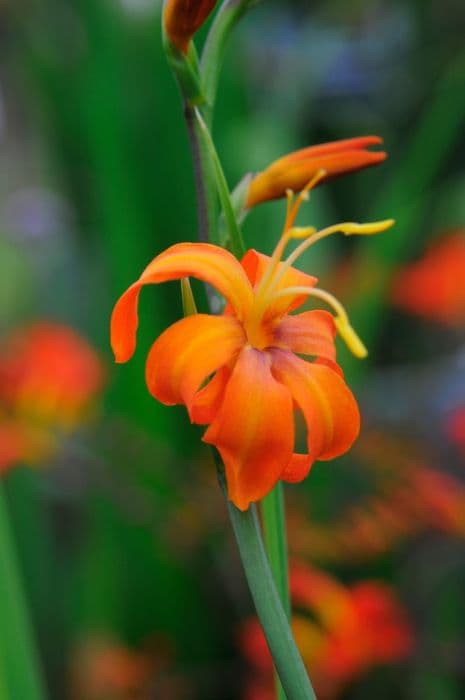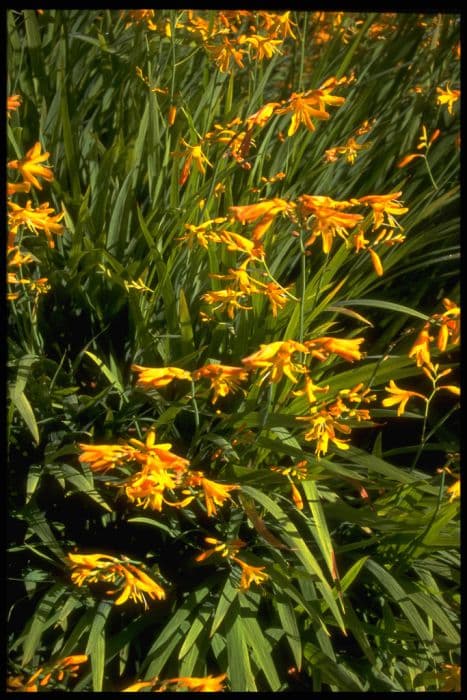Tall Bearded Iris Iris 'Owyhee Desert' (TB)

ABOUT
The Iris 'Owyhee Desert' is a remarkable plant known for its striking flowers, which are the most distinguishing feature. Its blossoms are a captivating blend of colors usually dominated by shades of purple, lavender, or violet, though they can also showcase a range of other hues like blues, yellows, or whites, depending on the specific variety. Each flower has six petal-like structures: three upright petals (standards) and three hanging petals (falls). The falls often display intricate veining or speckling and may have a splash of a contrasting color at their bases, known as beards, adding to their beauty. The foliage of this plant consists of long, slender, sword-shaped leaves that grow in a dense clump. The leaves are a deep green color, and they often have a slightly bluish or greyish tint. Their vertical and slightly arching arrangement gives the planth a graceful and structured look. The Iris 'Owyhee Desert' blooms typically in late spring to early summer, offering a spectacular display of color and form. The flowers are borne on sturdy stems that rise elegantly above the foliage and are capable of supporting the large, showy blossoms that make this plant a beloved choice for gardeners and flower enthusiasts.
About this plant
 Names
NamesFamily
Iridaceae.
Synonyms
Tall Bearded Iris, Owyhee Desert Iris.
Common names
Iris 'Owyhee Desert' (TB).
 Toxicity
ToxicityTo humans
The Tall Bearded Iris, like other members of the Iris genus, contains compounds that can be toxic to humans. The rhizomes (underground stems) are particularly known to contain irritant substances. If ingested, they can cause stomach pains, nausea, vomiting, and diarrhea. Handling the plant, particularly the rhizomes, may also cause skin irritation due to the presence of these compounds. It is advisable to wear gloves when dealing with the plant to avoid skin irritation and to avoid ingesting any part of the plant to prevent potential symptoms of poisoning.
To pets
The Tall Bearded Iris can be toxic to pets if consumed. The underground rhizomes contain substances that can irritate the stomach and gut, leading to symptoms such as vomiting, drooling, lethargy, and diarrhea. In cases of significant ingestion, more severe symptoms could occur. It's important to prevent pets from accessing and chewing on any part of this plant, especially the rhizomes, to avoid the possibility of Iris poisoning. If you suspect your pet has ingested this plant, seek veterinary attention promptly.
 Characteristics
CharacteristicsLife cycle
Perennials
Foliage type
Deciduous
Color of leaves
Green
Flower color
Mixed
Height
3 feet (91 cm)
Spread
1 foot (30 cm)
Plant type
Bulb
Hardiness zones
Varies
Native area
North America
Benefits
 General Benefits
General Benefits- Ornamental Value: Iris 'Owyhee Desert' adds visual appeal to gardens with its striking flowers and elegant foliage.
- Drought Tolerance: Once established, it is relatively drought-resistant, requiring minimal watering.
- Low Maintenance: This variety of bearded iris is easy to care for, needing only occasional maintenance to remove spent blooms and foliage.
- Cold Hardy: It can withstand cold temperatures, making it suitable for growth in a variety of climates.
- Attracts Pollinators: The flowers attract bees and butterflies, which are beneficial for pollination and the health of the garden.
- Seasonal Interest: It provides seasonal interest with its vibrant blooms in the spring and its structured leaves throughout the growing season.
- Versatility: Iris 'Owyhee Desert' can be used in borders, beds, and as a focal point in landscape designs.
- Propagates Easily: It can be easily divided to propagate new plants and expand garden displays or to share with other gardeners.
 Medical Properties
Medical PropertiesThis plant is not used for medical purposes.
 Air-purifying Qualities
Air-purifying QualitiesThis plant is not specifically known for air purifying qualities.
 Other Uses
Other Uses- Iris 'Owyhee Desert' can be used in landscape design, providing a stunning visual impact with its vibrant colors and distinctive blooms that can complement various garden themes.
- The tall bearded iris can serve as a natural barrier or border when planted in a row, helping to define different areas within a garden space.
- These irises can be used in cut flower arrangements, offering an elegant touch to bouquets and centerpieces with their unique shape and colors.
- Photographers and artists may use Iris 'Owyhee Desert' as a subject for their work, captivated by their striking appearance and enhancement of visual arts.
- Planting Iris 'Owyhee Desert' can attract and support local wildlife, such as bees and hummingbirds, which are drawn to their flowers for nectar.
- The tall bearded iris can serve as a companion plant to roses, helping to deter certain pests that commonly afflict rose bushes.
- Enthusiasts of plant breeding can use Iris 'Owyhee Desert' in their hybridization efforts to create new iris varieties with unique color combinations and features.
- Craft hobbies such as pressing flowers may include the petals of Iris 'Owyhee Desert', preserving their beauty in a different form and for various decorative uses.
- These irises can be used as part of a sensory garden, providing tactile and visual stimuli for an interactive garden experience.
- Iris 'Owyhee Desert' can play a role in educational gardens or programs, where they serve as examples of plant biology, horticulture, and the importance of biodiversity.
Interesting Facts
 Feng Shui
Feng ShuiThe Iris is not used in Feng Shui practice.
 Zodiac Sign Compitability
Zodiac Sign CompitabilityThe Iris is not used in astrology practice.
 Plant Symbolism
Plant Symbolism- Honor and Respect: The iris often symbolizes honor and respect, which harkens back to its use in heraldry and its association with Greek goddess Iris, who acted as the messenger of the Olympian gods.
- Royalty: Due to its regal appearance and stance, the iris can represent royalty or noble bearing, and it's often used to convey a sense of majesty and elegance.
- Wisdom: In some cultural contexts, the iris is associated with wisdom, likely due to its connection with the Greek goddess Iris, who was often linked with knowledge and messages from the divine.
- Hope and Faith: With its striking appearance, the iris can be used to symbolize hope and faith, suggesting that it stands as a beacon of optimism in difficult times.
- Purity: Particularly the white iris is often associated with purity and innocence, making it a common choice for weddings and religious ceremonies.
- Courage: The bold shape and variety of colors of the iris can serve as a symbol of courage and the celebration of one's individuality.
- Message: Inspired by the Greek goddess Iris, the flower can represent communication, the sharing of good news, or the arrival of a message.
 Water
WaterTall Bearded Iris should be watered deeply once a week during the growing season, ensuring about one to two gallons of water per square yard. It's important to avoid overwatering as this can lead to root rot. During the dormant season, in fall and winter, water only if the weather is exceptionally dry. Increase watering frequency to twice a week during hot, dry periods in summer, ensuring the soil around the plant remains moist but not waterlogged.
 Light
LightTall Bearded Iris thrives in full sun where it can receive at least six hours of direct sunlight each day. The ideal spot for planting is in an area with bright, unfiltered sunlight, which is vital for the production of large, vibrant blooms. Partial shade is tolerable but may result in fewer flowers.
 Temperature
TemperatureTall Bearded Iris prefers temperate climates with temperatures ranging between 55°F and 75°F for optimal growth. They can withstand winter temperatures as low as 5°F but require protection in climates where temperatures drop below this point. During the growing season, they can handle temporary spikes up to 90°F, but prolonged heat can be damaging.
 Pruning
PruningPruning Tall Bearded Iris involves removing the spent flower stems down to the base after blooming to encourage healthy growth and to maintain a neat appearance. In late summer or fall, cut back the foliage to a height of about six inches. This annual pruning helps to deter pests and diseases and prepares the plants for winter.
 Cleaning
CleaningAs needed
 Soil
SoilTall Bearded Iris like the 'Owyhee Desert' require well-draining soil with a slightly acidic to neutral pH level of 6.8 to 7.0. A good mix can be made with loamy soil, organic compost, and coarse sand to ensure adequate drainage, prevent root rot, and supply essential nutrients.
 Repotting
RepottingTall Bearded Iris, including 'Owyhee Desert', generally do not need to be repotted often. They should be divided and replanted every 3-4 years to maintain vigor and prevent overcrowding.
 Humidity & Misting
Humidity & MistingTall Bearded Iris like 'Owyhee Desert' prefer low to average humidity levels and are well-suited to typical outdoor conditions in the appropriate climate zones.
 Suitable locations
Suitable locationsIndoor
Provide bright light, good air flow, and cool nights.
Outdoor
Plant in full sun, well-draining soil, and space rhizomes out.
Hardiness zone
3-9 USDA
 Life cycle
Life cycleThe life of Iris 'Owyhee Desert', commonly known as Tall Bearded Iris, begins with seed germination, which occurs in late spring or early summer, given appropriately cold stratification to break dormancy. Following germination, the plant enters a juvenile vegetative stage where the growth of roots and leaves is prioritized. Over several seasons, the iris develops into a mature plant with a robust rhizome system capable of supporting blooms. Flowering typically occurs in late spring or early summer, showcasing the Tall Bearded Iris's characteristic large, ornate flowers. After the blooming period, the plant enters a period of vegetative growth and energy storage in the rhizomes to prepare for the next season. Eventually, the iris may enter a phase of clonal reproduction, with the rhizomes producing offsets, or "pups," that can be divided and planted to propagate new plants, thus continuing the life cycle.
 Propogation
PropogationPropogation time
Late Summer-Early Fall
Iris 'Owyhee Desert', typically known simply as the Tall Bearded Iris, is most commonly propagated through division of its rhizomes. This procedure is best done in late summer after the flowering period has ended. To propagate, the gardener should carefully dig up the existing clumps and use a sharp, clean knife or spade to divide the rhizomes into sections, ensuring that each piece has at least one fan of leaves and a portion of the roots. The divisions are then replanted into well-draining soil, spaced about 12 to 24 inches (30 to 60 centimeters) apart to allow for adequate growth. The top of the rhizome should be positioned just slightly below the soil surface. This method encourages rejuvenation of the plant and can help manage overcrowding, allowing for continued healthy growth and vibrant blooms in subsequent seasons.
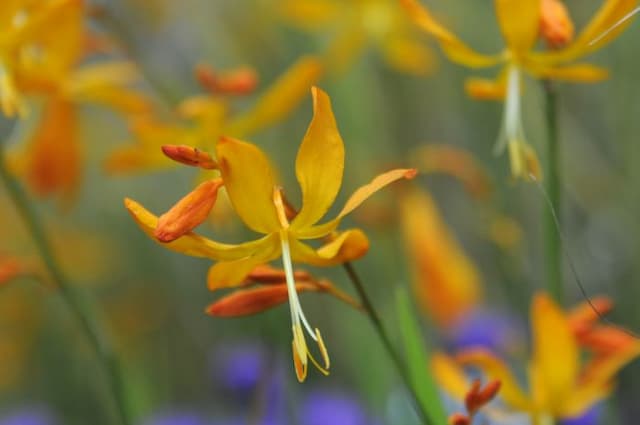
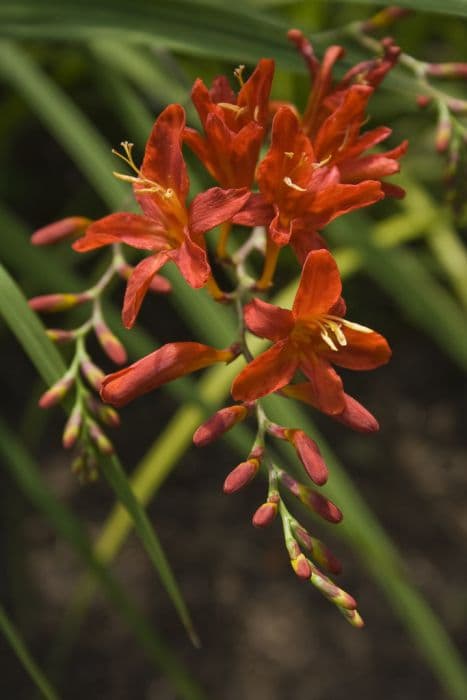
![Montbretia [Bright Eyes]](/_next/image?url=https%3A%2F%2Fplants-admin.emdemapps.com%2Fimages%2Fplants%2F%2Fimages%2F604b5f4a483b6.png&w=640&q=75)
